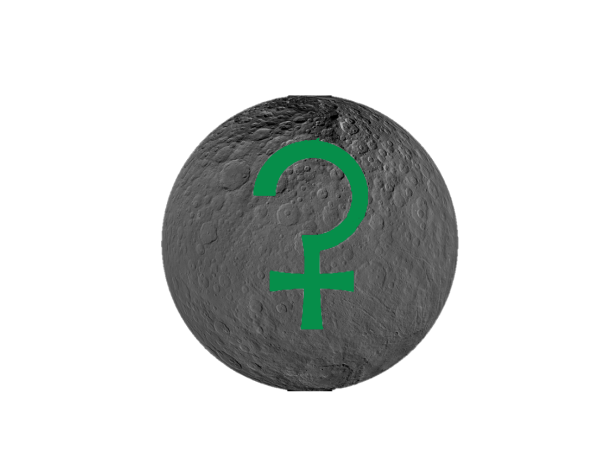CERES & THE RETURN OF THE GODDESS

When the ancients looked up to the cosmos, they saw seven travellers in the sky: Sun, Moon, Mercury, Venus, Mars, Jupiter, and Saturn. However, as our knowledge of the universe expanded, astrological insight evolved. Missing or outdated information was filled in or updated, and humanity gained a deeper understanding of itself and a greater perspective on its place in universal consciousness.
With that mind, arguably the biggest shake up in recent times has been the reclassification of Pluto from “planet” to “dwarf planet”. Astrologically, Pluto still holds his same significance and energy, but the reclassification brought awareness to other energies that were being smothered under the old parochial system, the most important of which were Eris and Ceres[1].
Discovered in 1801, Ceres (pronounced “series”) is the largest object in the asteroid belt between Mars and Jupiter. She is named for the Roman Earth Goddess whose main myth explores the joy and grief of motherhood through the cycle of life and death in the seasons. (Her Greek counterpart, Demeter, is part of my post VENUS and THE ELEUSINIAN MYSTERIES.)
Since her discovery, many other asteroids have been recognized and named but, like Ceres herself, they have spent much of their lives completely unknown by most and given only cursory glances in traditional astrology. Part of the problem is that most astrologers don’t delve too deeply into asteroids, but the other issue is that many of these asteroids (especially the big four – Ceres, Vesta, Juno, and Pallas) represent the faces of the divine feminine that have been ignored or suppressed in patriarchal astrology.
Eris, in particular, was none too pleased with this.
As the catalyst for the massive rethinking of our solar system, and subsequent reclassification of many celestial bodies, Eris (appropriately named for the Goddess of strife, discord, and chaos) made herself known in 2005 and demanded an astrological reckoning with regard to the patriarchal view of the cosmos. In the course of this re-examination, the planet Pluto and the asteroid Ceres were reclassified as dwarf planets – along with Eris herself – and the astrological world experienced a systemic overhaul.
(I hope to do a full write up on Eris in the future but, for now, if you have heard of the golden apple that required the judgement of Paris, which set off the Trojan War… that apple came from Eris.)
Ok, back to Ceres and what she represents.
Ceres
Archetype: Mother
Goddess associations: Ceres (Roman), Demeter (Greek), Modron (Welsh), Ninhursag (Sumerian), Gaia/Terra (Greek/Roman)
Mythology: Ceres represents all Earth and/or Mother Goddesses; She is Mother Earth
Theodomy: Ceres represents our Maternal Self and the urge to nurture and secure
Some keywords & ideas
nurturance, care, family
stability, security, peace
nature, earth & fertility cycles, growth
material & physical existence, wealth, possession, sensuality
unconditional love & acceptance
attachment & loss
powerful, stubborn, vengeful
The astrological community is slow in acknowledging the importance of Ceres (and the many other faces of the divine feminine). Theodomy, on the other hand, appreciates the importance of Ceres – as well as Eris, Vesta, Juno, and Pallas – and recognizes Ceres as the true guide/ruler of Taurus.
As a bit of background on traditional astrological “rulership”, the Sun and Moon “ruled” Leo and Cancer respectively, and the remaining five planets each ruled two signs. However, as Uranus, Neptune, and Pluto came along (universe expands, astrology evolves) each of those planets took over “rulership” of different zodiac signs, until only Venus and Mercury were left ruling two signs each.
With the explosive expansion of cosmic knowledge in the last decades, it seems obvious that astrology needs to evolve again. Where Venus still rules both Libra and Taurus in traditional astrology, Theodomy recognizes Venus as the guide of Libra and Ceres as the guide of Taurus[2]. And, yes, Theodomy prefers the term “guide” to “ruler”.
Ceres, the Earth Mother, is the ideal guide for quiet, stubborn, nature-loving Taurus. Furthermore, having Ceres in Taurus puts her opposite Pluto in Scorpio. Not only does this pair these two reclassified beings, but also creates a perfect balance in terms of the mythology and the energy.
In the mythology, Proserpina is the daughter of Ceres who spends half of the year on earth with her mother (Ceres) and the other half in the Underworld with her husband (Pluto).
Energetically, Ceres and Pluto[3] represent various balancing polarities, which – with the reclassification – are now on equal footing:
female and male
life and death
form and transformation
attachment and detachment
saving and spending
growth and decay
acquisition and loss
…respectively.
In conclusion, the evolution of astrology reflects the needs and direction of humanity’s general psyche. Theodomy promotes the re-emergence of the Goddess and her many faces, but Ceres – along with her sister energies – are the cosmic keys. Unlock the doors and feel Her power…
[1] There are now a total of 9 dwarf planets, but Pluto, Ceres, and Eris are the original three.
[2] If you are wondering about Mercury’s two signs, Theodomy recognizes Mercury as the guide of Gemini and Vesta as the guide of Virgo.)
[3] As the planet of transformation, it is rather apropos that Pluto caused change when he was discovered in 1930, and then became changed himself with a reclassification to dwarf planet in 2006.
